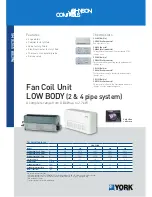
- 9 -
Cont ...
3 PUMP
CONNECTIONS
Do not use stainless steel, chrome or nickel plated pipe with the
flexible hose push-in plumbing connections.
Do not introduce solder flux into the joint or surrounding area as
connectors will be attacked and may fail and void warranty.
All solder joints should be completed and flux residues removed
before final connection to push-in connections, on the flexible hose.
Do not allow contact with oil or cellulose based paints, paint
thinners or strippers, acid based descalents or aggressive cleaning
agents.
Never operate pump with inlet and/or outlet isolating valves in the
closed position. Damage will occur!
3.11
Hose to pump:
Inlet - use hoses supplied with isolating valves built-in for the
inlets, push home onto the pump connections to a depth of 33 mm ensuring the
strainers are in place.
Outlet - use hoses suppled with no isolating valves and follow same process.
3.12
Hose to pipework:
1. These plastic push-in connectors, must only be connected with the following:
a) 22 mm diameter copper pipe to BS EN 1057 - R250 (half hard) - Table 3.
b) 22 mm plastic pipe to BS 7291 part 1 and part 2 (Table 1), or part 3
(Table 1) plus internal support sleeve*.
* The internal bore of the plastic pipe must be supported against collapse
with the pipe manufacturers recommended support sleeve (pipe insert).
c) Appropriate plumbing fittings that are compatible and will provide a water
tight
connection.
Ensure the pipe is free from all score marks and deformities in the area of the
insertion depth (Fig. 7) and cut the pipe square removing all burrs and sharp
edges to prevent damage to the sealing ‘O’-ring.
2. Prior to inserting pipe into fitting mark the insertion depth on the wall of the
pipe with a soft pencil at a distance of 33 mm from the end to be inserted.
Fig. 7
Pencil
mark
Insert depth
33 mm
22 mm Pipe






































